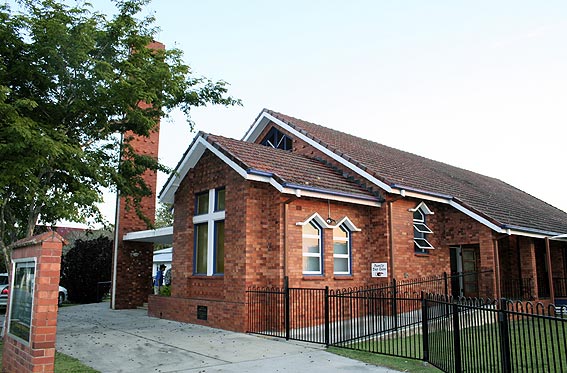
Gympie Uniting Church (formerly St Andrew's Presbyterian Church)
[Photograph by Trevor Bunning (October 2007)]

Gympie Uniting Church (formerly St Andrew's Presbyterian Church)
[Photograph by Trevor Bunning (October 2007)]
Historical and Technical Documentation by Geoffrey Cox
© OHTA 1989, 2007, 2011 (last updated November 2011)
The present brick Uniting Church, built in 1962 as St Andrew's Presbyterian Church, was preceded on the same site by two earlier churches in 1873 and 1884, both designed by the Swedish-born architect, Hugo Wilhelm Durietz, who had settled in Gympie around December 1867.1
The organ in the present church had been purchased from Henry Willis & Sons, London in 1884 by the Hon. W. Horatio Wilson, MLA of Brisbane, who intended to install it in his residence in Brisbane. The relevant entry in the firm's ledger reads as follows:
September 1884 Chamber organ without case . . . . . . £372.0.0
Value of returned case . . . . . . . . . . . . . . . . . . . . . . £ 32.0.0
to W. F. Wilson of Trinity College, Oxford
balance paid by Government account through National Bank
for W. H. Wilson.2
The Welsh-born solicitor, Walter Horatio Wilson had settled in Brisbane initially in 1865, and again in 1881 after a year's absence in the USA and England. He held various government posts between 1885 and 1899, including postmaster-general and minister of justice. Wilson founded the Brisbane Musical Union, became president of the Liedertafel, and was organist and choirmaster for twelve years at St Thomas's Anglican Church, Toowong. He died at his Toowong home in 1902.3 Wilson wrote for The Brisbane Courier under the name 'Euterpe,'4 and he is also associated with the installation of the organ in St Patrick's Catholic Church, Fortitude Valley.
The specification of the Willis instrument had been prepared by the prominent Brisbane organist, Mr W.G. Willmore, but the organ was found to be too large for chamber that had been built for it in Wilson's residence. It was installed instead in the Wickham Terrace Presbyterian Church in time for the opening of that building on 6 November 1887. The newly appointed organist, Mrs W.G. Willmore, gave the first of a series of recitals in the church on 18 April the following year.5
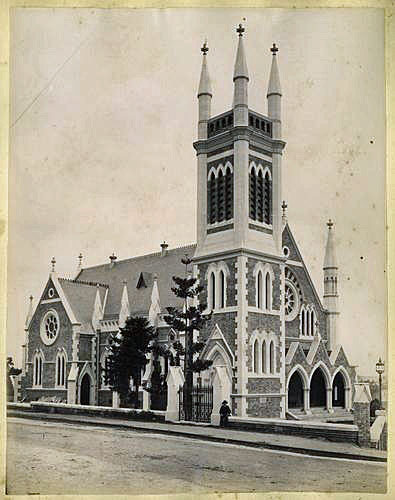
The Wickham Terrace Presbyterian Church, c.1895
[Photograph: John Oxley Library, State Library of Queensland]
When the Wickham Terrace Presbyterian congregation moved nearby into the new St Andrew's Presbyterian Church in 1905, 6 the Willis organ was sold to Mr John Vance of Gympie, who was advised that it could be removed from the Wickham Terrace Church as soon as possible after 21 August 1905.7 Vance was the minister at St Andrew's Gympie when the organ was installed there.8 It was installed initially in the 1884 timber church on the present site.
The original specification is deduced to have been as follows:
| GREAT Open Diapason Claribel flute Salicional Principal Lieblich flute SWELL Open Diapason Lieblich gedact Gemshorn Hautboy PEDAL Bourdon COUPLERS Swell to Great Great to Pedals Swell to Pedals |
8 8 8 4 4 8 8 4 8 16 |
[slotted pipes] [stopped bass; harmonic from mid.C] [gvd bass] [stopped metal treble] [long pierced wooden stoppers] [gvd bass] [long pierced wooden stoppers] [cylindrical] |
Swell tremulant
Compass: 56/30
Mechanical action.9
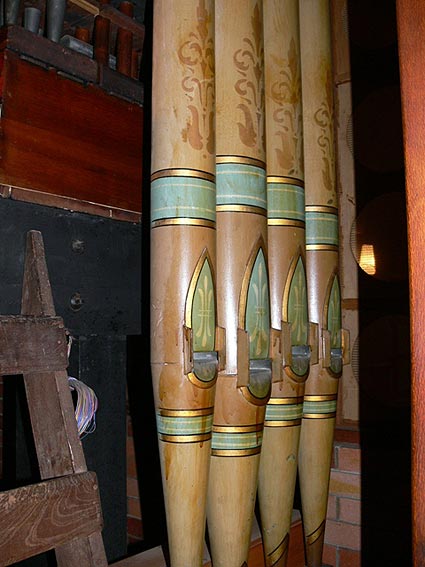
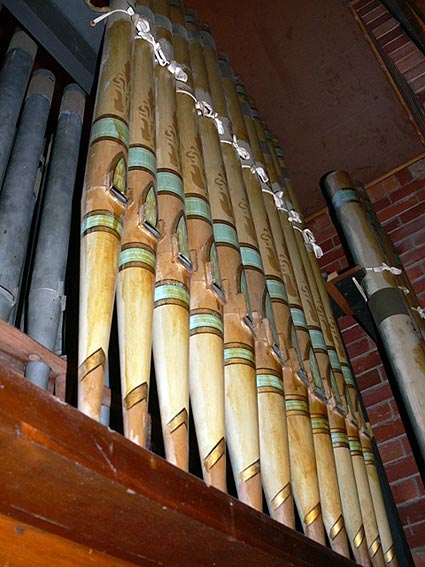
The original diapered front pipes of the organ,
apparently still in their original configuration
[Photographs by John Maidment (October 2007)]
There appears to have been some degree of reconstruction of the old church in March 1925, when The Brisbane Courier reported as follows:
The Gympie Presbyterian Church has just been reconstructed, and the pipe organ rebuilt. Reopening services are to be held tomorrow, when the Moderator, the Rev. James Gibson, M.A., will be the preacher.10
'Re-building' in this instance may simply have involved 're-assembly', as there is no evidence of any major change to the organ until 1962.
In 1962 the organ was electrified by Whitehouse Bros using electro-pneumatic action and installed in the present new church building. The organ is now completely hidden in a chamber at the rear of the church, and played from a detached stop-key console located in the gallery above. Three additional couplers were provided, and the manual compass was extended to 61 notes.11

The organ chamber on the right at the rear of the church
[Photograph by Trevor Bunning (October 2007)]
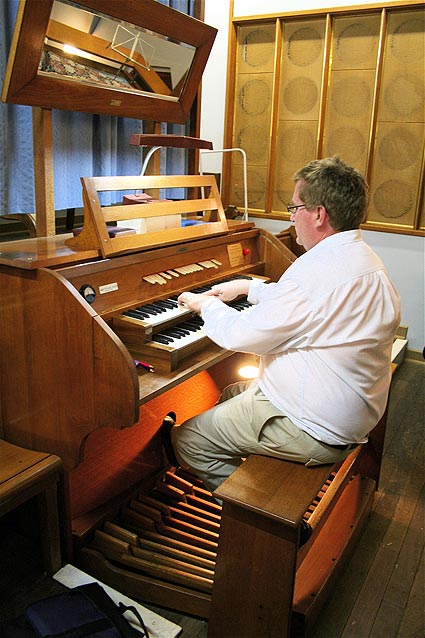
The 1962 detached console in the gallery
[Photograph by Trevor Bunning (October 2007)]
Although the original console was removed in 1962, much of the organ remains in its original state. The bellows were reduced to single-rise, but the original chests were retained, with the trackers cut below the soundboard. Although completely hidden, the front pipes of the Great Open Diapason retain their original diapering, and are apparently in their original configuration. All of the distinctive Willis pipework remains: The treble of the Great Claribel flute 8ft has large harmonic holes drilled through the metal pipes; and the Great Lieblich flute 4ft and Swell Lieblich gedact 8ft have long pierced tulip-shaped wooden stoppers. The Pedal Bourdon 16ft pipes lack ears, and have mahogany caps.12
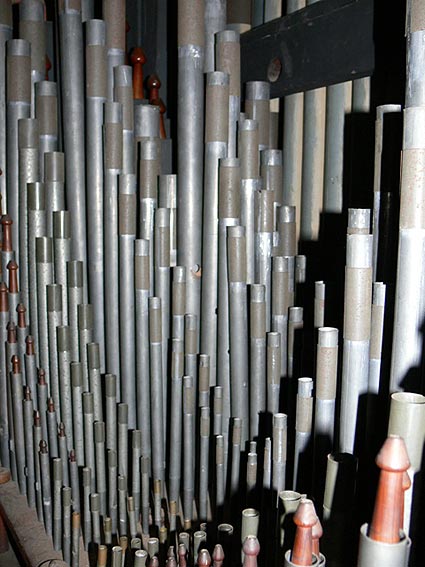
Great pipework, showing (left to right) the Lieblich flute 4ft, Principal 4ft,
Salicional 8ft, Claribel flute 8ft and Open Diapason 8ft
[Photograph by John Maidment (October 2007)]
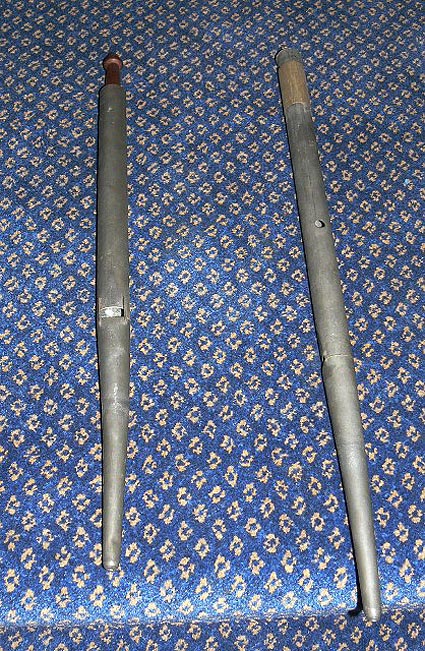
Pipes of the Lieblich flute 4ft (left) and Claribel flute 8ft (right)
[Photograph by John Maidment (October 2007)]
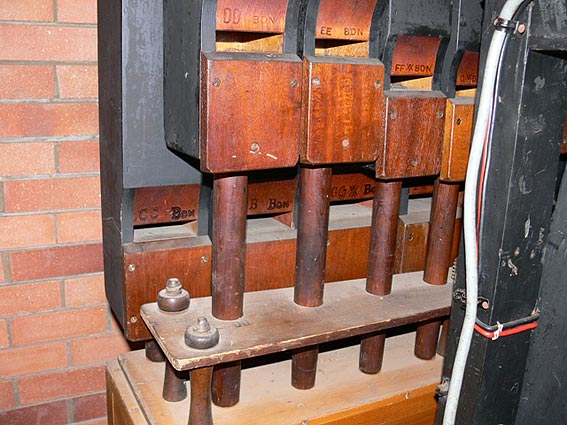
Bass notes of the Pedal Bourdon
with pitch indications stencilled on the upper lips
[Photograph by John Maidment (October 2007)]
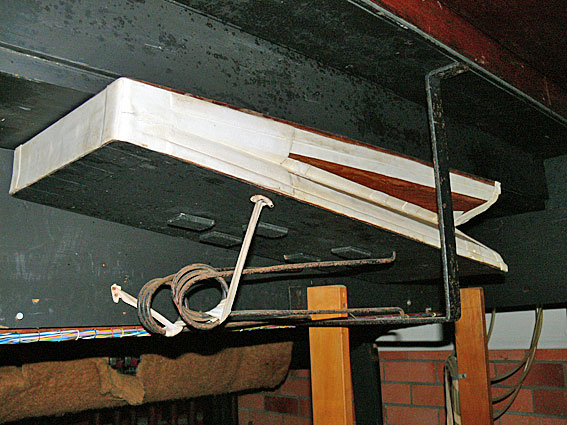
Original concussion bellows and springs
[Photograph by John Maidment (October 2007)]
_________________________________________________________________________
1 Donald Watson & Judith McKay, Queensland Architects of the 19th Century: A Biographical Dictionary (Brisbane: Queensland Museum, 1994), pp. 57-59.
2 Personal communication to G. Cox from Quentin Buchanan (Henry Willis & Sons Ltd), 5 February 1974.
3 J. C. H. Gill, "Wilson, Walter Horatio (1839-1902)", Australian Dictionary of Biography, Vol. 12 (Melbourne University Press, 1990), p. 531. Online version at http://adbonline.anu.edu.au/biogs/A120597b.htm - accessed March 2011.
4 W. Bebbington, "Wilson, William [sic.] Horatio" The Oxford Companion to Australian Music (Melbourne: Oxford University Press, 1997), p. 594.
5 The Brisbane Courier (19 April 1888), p. 5; The Brisbane Courier (7 November 1887), p. 5.
6 Richard Bardon, The Centenary History of the Presbyterian Church of Queensland, 1849-1949 (Brisbane: W. R. Smith & Paterson, 1949), p. 219.
7 Report of the Building Committee of St Andrew's Presbyterian Church, Brisbane, 3 October 1904 & 14 May 1905, cited by the late Mr Hugh Brandon, c.1974.
8 Bardon, p. 231.
9 Original specification and nomenclature deduced by John Maidment from internal inspection, July 1974.
10 The Brisbane Courier (14 March 1925), p. 9.
11 Specification noted by G. Cox, July 1974 & October 1989.
12 Observations by John Maidment, October 2007.